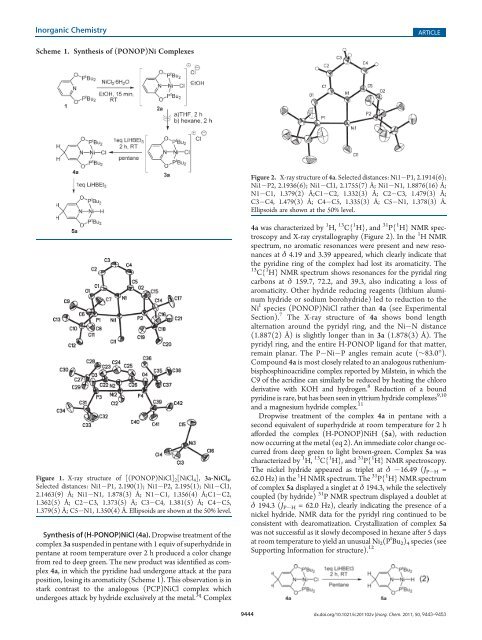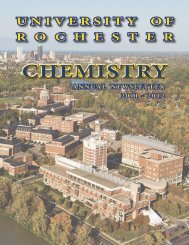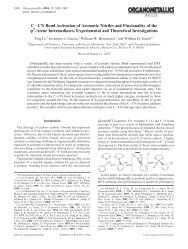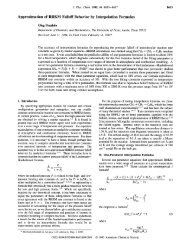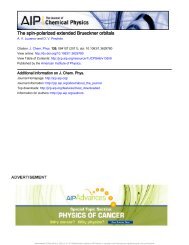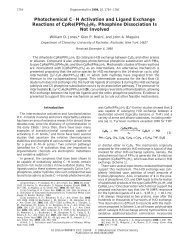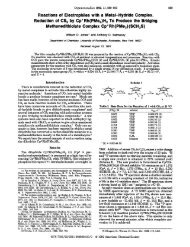Synthesis and Reactivity of New Ni, Pd, and Pt 2, 6-Bis (di-tert ...
Synthesis and Reactivity of New Ni, Pd, and Pt 2, 6-Bis (di-tert ...
Synthesis and Reactivity of New Ni, Pd, and Pt 2, 6-Bis (di-tert ...
Create successful ePaper yourself
Turn your PDF publications into a flip-book with our unique Google optimized e-Paper software.
Inorganic Chemistry<br />
ARTICLE<br />
Scheme 1. <strong>Synthesis</strong> <strong>of</strong> (PONOP)<strong>Ni</strong> Complexes<br />
Figure 2. X-ray structure <strong>of</strong> 4a. Selected <strong>di</strong>stances: <strong>Ni</strong>1 P1, 2.1914(6);<br />
<strong>Ni</strong>1 P2, 2.1936(6); <strong>Ni</strong>1 Cl1, 2.1755(7) Å; <strong>Ni</strong>1 N1, 1.8876(16) Å;<br />
N1 C1, 1.379(2) Å;C1 C2, 1.332(3) Å; C2 C3, 1.479(3) Å;<br />
C3 C4, 1.479(3) Å; C4 C5, 1.335(3) Å; C5 N1, 1.378(3) Å.<br />
Ellipsoids are shown at the 50% level.<br />
Figure 1. X-ray structure <strong>of</strong> [(PONOP)<strong>Ni</strong>Cl] 2 [<strong>Ni</strong>Cl 4 ], 3a-<strong>Ni</strong>Cl 4 .<br />
Selected <strong>di</strong>stances: <strong>Ni</strong>1 P1, 2.190(1); <strong>Ni</strong>1 P2, 2.195(1); <strong>Ni</strong>1 Cl1,<br />
2.1463(9) Å; <strong>Ni</strong>1 N1, 1.878(3) Å; N1 C1, 1.356(4) Å;C1 C2,<br />
1.362(5) Å; C2 C3, 1.373(5) Å; C3 C4, 1.381(5) Å; C4 C5,<br />
1.379(5) Å; C5 N1, 1.350(4) Å. Ellipsoids are shown at the 50% level.<br />
<strong>Synthesis</strong> <strong>of</strong> (H-PONOP)<strong>Ni</strong>Cl (4a). Dropwise treatment <strong>of</strong> the<br />
complex 3a suspended in pentane with 1 equiv <strong>of</strong> superhydride in<br />
pentane at room temperature over 2 h produced a color change<br />
from red to deep green. The new product was identified as complex<br />
4a, in which the pyri<strong>di</strong>ne had undergone attack at the para<br />
position, losing its aromaticity (Scheme 1). This observation is in<br />
stark contrast to the analogous (PCP)<strong>Ni</strong>Cl complex which<br />
undergoes attack by hydride exclusively at the metal. 3q Complex<br />
4a was characterized by 1 H, 13 C{ 1 H}, <strong>and</strong> 31 P{ 1 H} NMR spectroscopy<br />
<strong>and</strong> X-ray crystallography (Figure 2). In the 1 H NMR<br />
spectrum, no aromatic resonances were present <strong>and</strong> new resonances<br />
at δ 4.19 <strong>and</strong> 3.39 appeared, which clearly in<strong>di</strong>cate that<br />
the pyri<strong>di</strong>ne ring <strong>of</strong> the complex had lost its aromaticity. The<br />
13 C{ 1 H} NMR spectrum shows resonances for the pyridal ring<br />
carbons at δ 159.7, 72.2, <strong>and</strong> 39.3, also in<strong>di</strong>cating a loss <strong>of</strong><br />
aromaticity. Other hydride reducing reagents (lithium aluminum<br />
hydride or so<strong>di</strong>um borohydride) led to reduction to the<br />
<strong>Ni</strong> I species (PONOP)<strong>Ni</strong>Cl rather than 4a (see Experimental<br />
Section). 7 The X-ray structure <strong>of</strong> 4a shows bond length<br />
alternation around the pyridyl ring, <strong>and</strong> the <strong>Ni</strong> N<strong>di</strong>stance<br />
(1.887(2) Å) is slightly longer than in 3a (1.878(3) Å). The<br />
pyridyl ring, <strong>and</strong> the entire H-PONOP lig<strong>and</strong> for that matter,<br />
remain planar. The P <strong>Ni</strong> P angles remain acute (∼83.0°).<br />
Compound 4a is most closely related to an analogous rutheniumbisphosphinoacri<strong>di</strong>ne<br />
complex reported by Milstein, in which the<br />
C9 <strong>of</strong> the acri<strong>di</strong>ne can similarly be reduced by heating the chloro<br />
derivative with KOH <strong>and</strong> hydrogen. 8 Reduction <strong>of</strong> a bound<br />
pyri<strong>di</strong>ne is rare, but has been seen in yttrium hydride complexes 9,10<br />
<strong>and</strong> a magnesium hydride complex. 11<br />
Dropwise treatment <strong>of</strong> the complex 4a in pentane with a<br />
second equivalent <strong>of</strong> superhydride at room temperature for 2 h<br />
afforded the complex (H-PONOP)<strong>Ni</strong>H (5a), with reduction<br />
now occurring at the metal (eq 2). An imme<strong>di</strong>ate color change occurred<br />
from deep green to light brown-green. Complex 5a was<br />
characterized by 1 H, 13 C{ 1 H}, <strong>and</strong> 31 P{ 1 H} NMR spectroscopy.<br />
The nickel hydride appeared as triplet at δ 16.49 (J P H =<br />
62.0 Hz) in the 1 H NMR spectrum. The 31 P{ 1 H} NMR spectrum<br />
<strong>of</strong> complex 5a <strong>di</strong>splayed a singlet at δ 194.3, while the selectively<br />
coupled (by hydride) 31 P NMR spectrum <strong>di</strong>splayed a doublet at<br />
δ 194.3 (J P H = 62.0 Hz), clearly in<strong>di</strong>cating the presence <strong>of</strong> a<br />
nickel hydride. NMR data for the pyridyl ring continued to be<br />
consistent with dearomatization. Crystallization <strong>of</strong> complex 5a<br />
was not successful as it slowly decomposed in hexane after 5 days<br />
at room temperature to yield an unusual <strong>Ni</strong> 2 (P t Bu 2 ) 4 species (see<br />
Supporting Information for structure). 12<br />
9444 dx.doi.org/10.1021/ic201102v |Inorg. Chem. 2011, 50, 9443–9453


